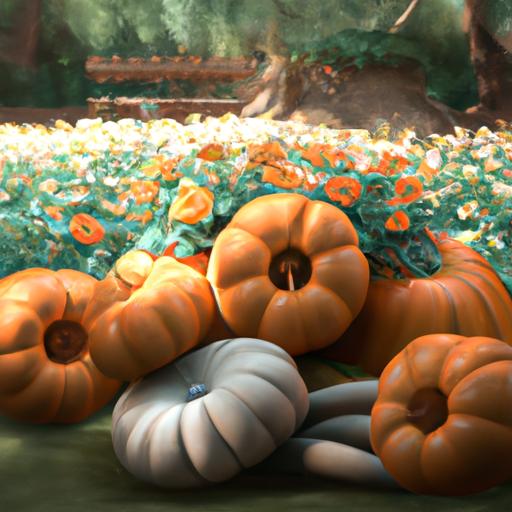With fall in full swing and pumpkin everywhere, it’s important to know how to tell if pumpkin is bad so you can enjoy all the delicious dishes made with this versatile vegetable.
In this guide, we’ll show you how to tell if your pumpkin is fresh and keep it that way so you can make the most of this seasonal favorite.
From simple tips to more advanced methods, we’ll help you tell if pumpkin is bad and keep it fresh.
Read on to learn more!
Table of Contents
How To Tell If Pumpkin Is Bad?
To determine if a pumpkin is bad, look for these common signs.
Visually, the pumpkin should be firm and have a smooth skin.
If it looks bruised, shriveled, or has any soft spots, it is likely bad.
If it is slimy, it is starting to spoil.
Give it a sniff; a bad pumpkin will have a strong, off-putting aroma.
And give it a gentle squeeze; if it gives easily, it is likely bad.
A good pumpkin should be firm and resilient.
When storing pumpkins, keep them at room temperature in a cool, dry place.
If stored correctly, pumpkins can last for several weeks.
However, if you’re not sure about the quality, it’s best to discard it and get a new one.
How Do You Tell If A Pumpkin Is Rotten On The Inside?

Determining if a pumpkin is rotten on the inside can be tricky. To start, inspect the outside: soft spots, black spots, mold, or a foul smell are likely signs of the pumpkin being rotten. If the outside looks good, press down with your thumb: a solid, firm pumpkin is healthy, while soft and spongy indicates a rotten one. Color is also a factor: a strong orange color indicates a healthy pumpkin, whereas dull or brown/yellow patches indicate a rotten one.
If you’re still not sure, tap the pumpkin with your knuckle: a healthy one will make a clean, deep sound, while a rotten one will make a dull, thudding sound. If all else fails, cut the pumpkin open to look for mold or soft spotsthese are definite signs of a rotten pumpkin.
In conclusion, inspect the outside of the pumpkin for signs of rot, press down on it, tap it with your knuckle, or cut it open to confirm if it is rotten on the inside.
How Long Does It Take For A Pumpkin To Go Bad?
When it comes to the longevity of a pumpkin, it all depends on the conditions in which it’s kept.
Depending on the temperature and humidity, a pumpkin can last anywhere from a few days up to several months.
For best results, it’s recommended to use a pumpkin within a few weeks of harvesting it.
Optimal storage temperatures for pumpkins are between 45F and 50F.
If stored in a cool and dry location, a pumpkin can last up to three months.
In contrast, if the environment is warmer and more humid, the pumpkin will spoil more quickly.
When pumpkins start to go bad, they become soft and mushy and their skin may become yellow or brown.
Additionally, they may develop a sour smell.
Therefore, it’s important to check the pumpkin for any signs of spoilage before using it.
If it looks and smells okay, it can be used for cooking or carving.
If not, it’s best to discard it.
What Does Bad Pumpkin Smell Like?
Bad pumpkin can have a very unpleasant smell.
Its odor is often described as a mix of musty, rotten, sour, and moldy.
It can also have a slightly sweet and acidic scent, depending on the type of pumpkin.
Most people agree that the smell of bad pumpkin is very unpleasant and strong enough to fill up an entire room.
The smell of bad pumpkin is caused by the combination of compounds naturally found in the pumpkin, along with the growth of bacteria and mold.
The odor is most evident if the pumpkin has been left outside for a long period of time, as this allows bacteria and mold to grow on the outside and inside of the pumpkin.
The longer the pumpkin is left outside, the stronger the smell will be.
Improper storage can also cause the smell of bad pumpkin.
If you think you have a bad pumpkin, the best thing to do is to discard it and replace it with a fresh one.
The smell of bad pumpkin is not something you want to experience and can be quite off-putting.
If you do end up with a bad pumpkin, you can try to clean it with a mixture of water and bleach, then dispose of it in a sealed plastic bag.
What Does Bad Pumpkin Puree Look Like?

Bad pumpkin puree is easily identifiable by its color, texture, smell and taste.
It should be an orange-yellow hue, rather than dull or brownish.
When it comes to texture, it should be smooth and creamy, not lumpy or stringy.
It should also have a sweet, slightly earthy smell.
The taste should be subtle and sweet, with no bitterness or sourness.
If any of these characteristics are off, it’s likely past its expiration date and should be discarded.
Is My Pumpkin Still Good To Eat?
If you’ve had your pumpkin for more than a few weeks, it’s likely past its prime.
Pumpkins are best when eaten soon after they’re harvested in the fall.
But if it’s been stored in a cool, dry place, it should still be edible.
To check if your pumpkin is still good, inspect the outside.
If the skin is soft, wrinkled, or discolored, it’s likely gone bad.
Give it a sniff too if it smells sour or musty, it’s no good.
If it’s firm and bright, and smells sweet and fresh, it should still be good.
Cut the pumpkin open and take a look inside.
If the inside is slimy or discolored, it’s gone bad.
If it’s still firm and bright, it’s probably still good.
If you’re still not sure, cook the pumpkin and see how it tastes.
If it’s still good, you can use it in recipes.
If it’s gone bad, you can compost it and start fresh with a new pumpkin!
How Long Does It Take For An Uncarved Pumpkin To Rot?
The rotting process of an uncarved pumpkin is affected by three main factors: environment, size, and type. The temperature and humidity of the environment the pumpkin is stored in is the most important factor. A warm, humid environment will cause the pumpkin to rot quickly, usually within a week or two. However, cooler, drier conditions can extend the life of a pumpkin, potentially lasting for several weeks. Small pumpkins have a higher surface area-to-volume ratio, meaning more air can reach their inner parts, thus rotting faster than larger pumpkins. Pumpkins with thicker walls, such as sugar pumpkins, take longer to rot than those with thinner walls, such as jack-o-lantern pumpkins. In general, the amount of time it takes for an uncarved pumpkin to rot can range from a few days to several weeks.
Can Pumpkins Rot From The Inside Out?

Pumpkins are a type of fruit with a hard exterior that can rot from the inside out.
This happens when moisture and sugars inside the pumpkin attract mold, which weakens the walls and makes the pumpkin soft and mushy.
While this may seem like a bad thing, it is actually beneficial for the environment as the rotting pumpkin releases its nutrients and minerals back into the soil, providing nutrition for the next generation of pumpkins.
Rotting can also be caused by environmental factors, such as too much moisture or extreme temperatures, or if the pumpkin is not receiving enough sunlight.
To prevent rotting, store pumpkins in a cool, dry place, and water them regularly if you are growing them.
If you notice any signs of rotting, such as soft spots on the pumpkin, discard it quickly to prevent the spread of rot to other pumpkins.
Will Pumpkins Go Bad Inside?
The answer to whether pumpkins can go bad indoors is both yes and no.
It depends on the type of pumpkin, how long it has been stored, and the storage conditions.
If pumpkins are kept in a cool and dry place such as a cellar or pantry, they can last for several months.
Large pumpkins, like those used for jack-o-lanterns, are ideal for indoor storage as they have a thicker rind, which can withstand longer storage periods.
However, if the pumpkin is stored in a warm environment or has been stored for too long, it will start to go bad.
The rind will become soft and the color will change from orange to yellow.
The flesh may become mushy and develop an unpleasant sour smell.
In conclusion, if you want your pumpkin to last as long as possible, make sure to store it in a cool and dry place and use it within a few months of purchase.
Do Pumpkins Mold From The Inside Out?
Pumpkins can indeed mold from the inside out.
This is because they are made up of 90% water and are relatively low in acidity, which makes them a prime target for mold.
All it takes is for a single mold spore to take root and spread through the pumpkin’s inner flesh.
The mold growth is usually not visible from the outside, as it begins to form in the inner rind, which is much thicker than the outer layer.
As the mold continues to spread, the inner rind will become discolored and may appear as a white or grayish film.
In some cases, the mold will even spread to the stems and leaves, leading to decay.
To help prevent mold from forming, it is best to keep pumpkins in a cool, dry place, away from direct sunlight and damp environments.
Regularly inspect them for signs of discoloration, and if you notice any, remove it from the pumpkin to avoid further mold growth.
What Does Pumpkin Mold Look Like On The Inside?

Pumpkin mold, also known as powdery mildew, is a common fungal disease that affects pumpkins and many other vegetables.
It is characterized by the presence of white, powdery spots on the surface of the pumpkin and its leaves.
On the inside, the mold may appear in various forms, such as a thin, white coating resembling dust, or a light, powdery film.
These spots may thicken and become yellowish, and the surface of the pumpkin may become rough.
The mold can also spread to the inner parts of the pumpkin, forming a fuzzy, grayish-white coating on the walls and seeds.
This can give the pumpkin an uneven shape, and the seeds may be coated with a white, powdery substance.
The inner flesh may become discolored and mushy.
In severe cases, the pumpkin may become soft and watery, and may develop yellowish-brown spots.
Eventually, the mold will cause the pumpkin to rot and break down.
To prevent pumpkin mold, it is important to control humidity and avoid overcrowding of plants.
It is also essential to keep the foliage dry, especially after rainfall or irrigation.
If pumpkin mold is detected, it is best to dispose of the fruit to avoid further spread of the disease.
Final Thoughts
Now that you know how to tell if pumpkin is bad, you can make the most of this seasonal favorite.
Whether you’re looking for simple tips or more advanced methods, the information here has you covered.
So next time you get some pumpkin for a dish, you’ll know exactly what to do to keep it fresh.
Enjoy all the delicious dishes you can make with pumpkin this fall, and happy cooking!

